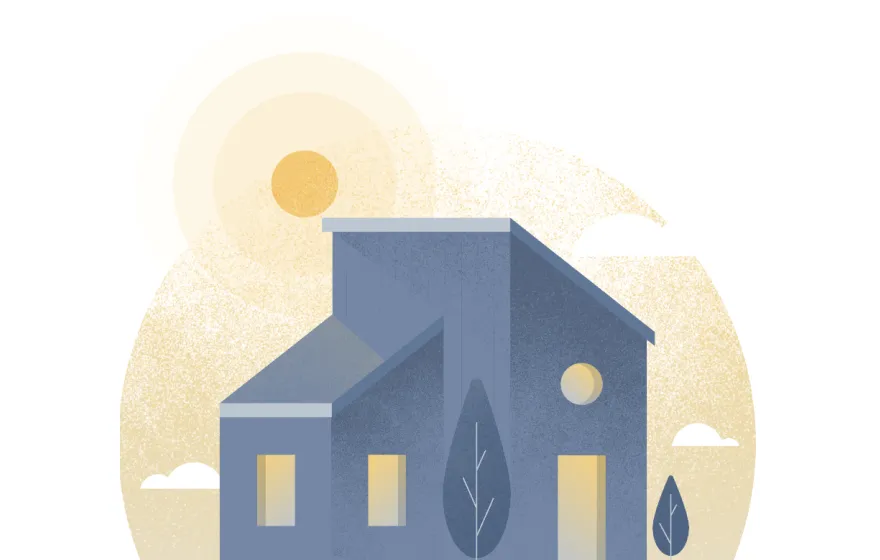Home equity loans and lines of credit (also known as HELOCs) are some of the most valuable tools that homeowners have in their back pocket. The right financing option can enrich your life, but each tool also has costs that you need to weigh, too.
Home equity loans and lines of credit seem very similar — and indeed, they are. In fact, it’s often challenging for homeowners to fully understand the differences between these two financing tools. We’ll take a closer look at those differences in this article, including the pros and cons of home equity loans and lines of credit when compared with each other.
What are the differences between a home equity loan and line of credit?
Home equity loans and HELOCs share many similarities, but they also have several key differences, too. When you look at the nuts and bolts of each financing option, it’s easier to see the differences, which — in turn — can help you understand the pros and cons of home equity loans and lines of credit better.
Fees
Both options charge closing costs, which typically range from 2% to 5%. HELOCs, however, may come with more ongoing account management fees because they’re designed to be used over and over again.
Interest rate
Home equity loans generally charge fixed interest rates, whereas HELOCs typically charge variable interest rates. Some HELOC lenders offer a hybrid fixed-rate structure, such as charging a fixed rate for each individual disbursement or allowing you to pay a fee during the draw period to lock in your rate on existing balances.
Debt structure
Home equity loans are, as the name implies, an installment loan. Once you take the loan out, you can’t borrow more on that existing loan. HELOCs, however, are a line of credit that allows you to borrow as needed during a five- to 10-year draw period, followed by a 10- to 20-year repayment period.
Monthly payment
Home equity loan payments are stable and don’t change, because you’re repaying the loan at a fixed rate without adding to the balance. HELOC payments can fluctuate wildly over time as interest rates and your outstanding balance rise and fall. Plus, you’re only required to make interest-only payments during the draw period, while full principal and interest payments are due during the repayment period.
Funds disbursement
Lastly, the biggest difference of all: with a home equity loan, you’ll receive a lump sum payout. You can’t take out additional funds, so if you need to borrow more, you’ll need to apply for a separate loan. A HELOC, however, allows you to borrow multiple times during the draw phase, up to your credit limit.

Home equity loan vs. line of credit: Pros and cons
Next, we’ll explore what these differences mean to you, in real terms.
We’ll skip past shared commonalities when it comes to pros and cons of home equity loans and HELOCs, such as having a lien filed on your home in either case, since those are covered elsewhere. Here, we’ll focus mainly on the differences in pros and cons.
Home equity loan pros
- Lower costs: Home equity loans typically charge lower interest rates than HELOCs, and you’ll begin paying down your balance immediately. Additionally, home equity loans don’t charge ongoing fees, such as annual maintenance or draw fees, unlike HELOCs.
- Stable payment: Your monthly payment remains the same from the first to the last payment. That makes it easy to plan for in your budget, especially if you’re living on a fixed income.
- Protection from rising rates: Your interest rate is locked in when you take out the loan. If rates rise in the future, yours will stay the same, and you won’t need to worry about your loan costs increasing.
- Avoid spending temptations: A home equity loan forces you to be more intentional about the money you borrow because you only get one disbursement of funds. It’s a self-limiting protection against borrowing too much money.
- Potential for faster repayment: A home equity loan forces you into a built-in payment schedule. You can’t string the debt along further by making interest-only payments for years, like you can with a HELOC.
Home equity loan cons
- Lack of flexibility: It’s not uncommon to need additional funds, such as if your home improvements or repairs are going over budget. If you opt for a home equity loan, though, you’ll need to apply for a whole new loan to get funding, which costs more time and money.
- Overpayment risk if rates fall: If interest rates fall, you could be stuck paying a higher interest rate. The only way to save money at that point is by refinancing your home equity loan, but this comes with additional closing costs as well.
- Higher required payments to start: You’ll start making full payments on the home equity loan right away. Unlike HELOC borrowers, you don’t get the option of making interest-only payments to start.
Home equity line of credit pros
- Lots of flexibility: Quite simply, HELOCs allow you more control over how much you borrow, when you borrow, and how much you pay each month.
- More payment freedom: Many people keep a HELOC for emergencies only and maintain a $0 balance, which means no monthly payments are required. If you do borrow, you can also choose to make interest-only payments in the draw period, or you can repay extra to save on interest and refresh your credit limit availability.
- Easy savings if rates fall: If interest rates start going down, your HELOC should follow suit, too. That means you don’t have to refinance to take advantage of lower rates, as you’d have to do with a home equity loan.
Home equity line of credit cons
- Higher costs: HELOCs often come with numerous ongoing fees, including inactivity fees and annual fees. Plus, if you make interest-only payments during the draw period, you could be charged these high rates for years since you won’t be reducing your balance.
- Overspending risk: It’s often easy to borrow too much money when you have easy access to credit. Anyone who’s ever run up a balance on credit cards understands this fact well, except that with a HELOC, it’s now tied to your home.
- Fluctuating payments: HELOC payments can pinball all over the place, depending on where interest rates are currently sitting, how much you’ve borrowed, and whether you’re in the draw or repayment phase. That can cause financial difficulties if, for example, your minimum payments jump to a level you can’t afford.
- Complicated structure: HELOCs can be trickier to understand than most other consumer debts because they’re split up into two different phases, with shifting interest rates. Many lenders add additional twists and features into the mix, too, like fixed-interest options, which can make them harder to understand.
- Vulnerable to rising rates: If rates rise, so will your monthly payment, and — hence — the total cost of the loan. No one can see the future, so you’re signing up for an unknown final price tag. This also has the potential to put your monthly payment beyond what you can afford.
When a home equity loan makes sense
Although HELOCs tend to be far more popular than home equity loans, there are many times when a loan might work better for you:
- You know exactly how much you need to borrow.
- You don’t need to borrow additional funds later on.
- You can afford to start making full monthly payments right away.
- You want a more cost-effective way to borrow against home equity.
- You’re on a fixed income and can’t afford large swings in your monthly payment.
- You want to remove the temptation to borrow additional funds when it may not be necessary.
When a home equity line of credit makes sense
There are many reasons why people prefer HELOCs over home equity loans. See how well you align with these points, which could indicate that HELOCs are your better option:
- You want a backup source of funds for emergencies.
- You want the option to borrow more money over the next few years.
- You want the option to make interest-only payments during the draw phase.
- You’re willing to pay a higher overall cost for the benefits a HELOC provides.
- You have enough income to cover the monthly payments if — and when — they rise.
- You have a good handle on how your HELOC works, so you can plan in advance for how it adjusts over time.
Home equity loan and HELOC alternatives
Home equity loans and lines of credit are popular ways to borrow money, but there are a few other options you should investigate first. One of these alternatives may work better for you, or — at the very least — you’ll get more confirmation that you’ve made the right pick.
- Personal loan: These unsecured loans charge higher fixed interest rates than home equity loans, but they’re often quicker and cheaper to get, and an overall better fit for smaller financing needs.
- Reverse mortgage: If you’re over age 62, you can borrow against your home equity with no monthly payments. It’ll be repaid after you and your eligible spouse no longer need the home.
- Cash-out refinance: A cash-out refi essentially allows you to roll your home equity loan and mortgage together into one debt, by replacing your current mortgage with a larger one. You’ll get the extra cash back, and repay it with one single loan.
- Home equity investment: A home equity investment (HEI) provides a lump sum in exchange for a portion of your home’s future equity growth. It requires no monthly payments, and the financing costs depend on how your home appreciates over time. Homeowners can qualify with a credit score above 500 and sufficient equity — there are no income requirements.
Frequently asked questions
Which is better, a home equity loan or a home equity line of credit?
Both options are better suited for different purposes. Home equity loans are better if you’ve got a specific project or need in mind, and you want better control over your costs. A HELOC is better suited to cover shifting borrowing needs, often at a higher overall cost.
How is a $50,000 home equity loan different from a $50,000 home equity line of credit?
You’ll start paying back a $50,000 home equity loan once the funds are disbursed — and, once paid off, you can’t take out additional funds without applying for a new loan. A $50,000 HELOC lets you make interest-only payments to start, which should be smaller, although your monthly payments will rise dramatically if you don’t repay some or all of that debt before switching to the repayment phase in a few years.
What are the risks of taking out a home equity loan or line of credit?
Both options carry the risk of foreclosure if you don’t repay the debt, because you’re using your home as collateral. That’s true of all home equity financing options, but some, like reverse mortgages or home equity investments, might be a better fit if you anticipate any payment challenges because the debts aren’t repaid immediately. It may also be easier to qualify with lower credit scores, too.

Final thoughts
You’ve worked hard to build equity in your home, and it can still yield you even bigger savings. They’re the perfect options for things like home renovations because interest may be tax deductible, for example. Plus, with long term lengths of up to 20 years (or more, in some cases), they’re a good option for larger borrowing needs.
In general, though, home equity loans are a better option if you’ve got a specific borrowing need in mind and want the cheapest option possible. If you want the freedom to borrow more money when you need it and you’re not afraid of paying a higher cost to get that, choose a HELOC.
No income? No problem. Get a home equity solution that works for more people.
Prequalify in 60 seconds with no need for perfect credit.
Show me my offer
Frequently asked questions

Thank you for subscribing!
.webp)















